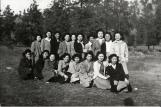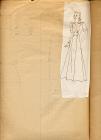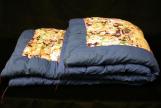15
Dress with pleated skirt sketch and pattern from Hatsuno Inouye's pattern book1943
Slocan City, BC
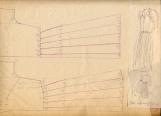
17
Full length evening gown sketch and pattern from Hatsuno Inouye's pattern book1944
Slocan City, BC
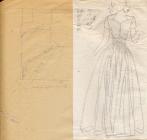
21
Pamphlet cover entitled 'How to Learn Dressmaking by Yourself' by Yoshiko Sugino1930
Slocan City, BC

22
Gloria Sato, from "Sandon: One 1943 Day in a Mountain Camp."I spent the afternoon sewing. I had taken some simple lessons on blouse drafting, and my first effort was just so-so. I make some adjustments on the pattern and lay it out on a piece of fabric.
Tomorrow, I shall start sewing the garment on the old Singer treadle machine. It is being used constantly. That machine is the only piece of furniture that Mother asked to have sent over from Cumberland. It came from Walter and Jessie Clarke, who looked after our house when we left Vancouver Island. They were the best neighbours we could have asked for.
Moritsugu, Frank and the Ghost Town Teachers Historical Society. (2001) Teaching in Canadian Exile: A history of the school for Japanese-Canadian children in B.C. detention camps during the Second World War. The Ghost-Town Teachers Historical Society. Toronto, Canada. Page 160.
24
Lurana Kikko Tasaka"All our sheets and pillow cases were from rice sacks - and then there were people that were making undergarments with them too - my mother did. Some people didn't, maybe they had a little more money, and were able to afford the flannel ... many had to resort to that. And the army surplus store ... we used to get all the old uniforms, take it apart and make pants and jackets for all the boys.
... Everything we wore was made and I remember sometimes there wasn't enough material for the youngest ones, so they would add a little bit of white there. They were so economical in those days ..."
From a conversation with Susan Michi Sirovyak, Japanese Canadian National Museum, July, 1996.
25
Portrait of the Academy of Domestic Arts at Greenwood, BC, in 1945. Courtesy Ruth Hamaguchi.22 April 1945
Greenwood, BC
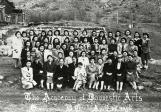
26
Ruth HamaguchiBased in Steveston before the war, the Academy of Domestic Arts was established in Greenwood by its principal and teacher, Mrs. Matsuzaki. Ruth Hamaguchi (nee Oyama) attended the Academy of Domestic Arts during her internment in Greenwood, B.C., studying under the direction of Mrs. Matsuzaki.
"Well, Mrs. Matsuzaki was quite a sewer, you know ... She worked from morning 'til late, 'til ten o'clock. She had three grown children then. They were in high school, you know. And since we didn't have much to do, she organized this place ... She taught us patterns. I learned to make patterns, and we took material ... The cutting part, she helped us and ... you've got to know how to do it properly ... First things first, or else if you sew the odd things last, the last things first - you make a mistake ... She was very particular. A lot of these girls, they made their clothes after that, suits ... Some, they knew sewing from Vancouver and they continued to make harder things, like coats and pants and everything."
From a conversation with Susan Michi Sirovyak and Naomi Sawada, Japanese Canadian National Museum, July 1996.
27
Portrait of the sewing class at East Lillooet, BC, ca. 1945. Courtesy Yosh Kariatsumari.1945
Lillooet, BC
